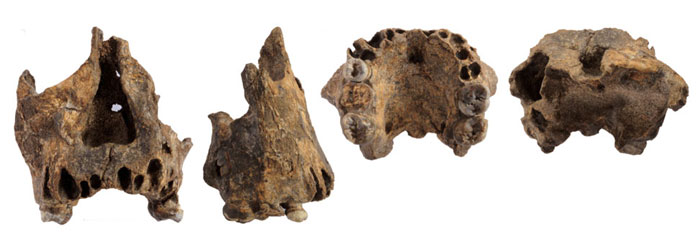What was their first task upon discovering the fossils? According to long-time African hominid fossil expert and anatomist Bernard Wood who summarized the Leakey finds in a short article in the same issue of Nature, "The task of palaeoanthropologists is to reconstruct the evolutionary history of the period between our species, Homo sapiens, and the ancestral species we share exclusively with chimpanzees and bonobos."2
So much for objective science, which would entail evaluating the fossils against evolutionary and competing tenets, not force-fitting them into evolutionary preconceptions. After all, a century of searching has failed to produce one fossil that can wear the undisputed tag of "ancestral species."
Wood said the three new fossils challenge a view that he had published in 1992. Back then, he attributed a large lower jaw to a fossil human variety named Homo rudolfensis whose identity has been contested for decades.3 The two new lower jaw fossils, found near the same rock outcrop and having the same general shape as the lower jaw he once attributed to H. rudolfensis, now look like poor fits for H. rudolfensis.
They may, instead, belong to yet another "species" or extinct variety of true humans. According to the Nature authors, the new fossils support the idea that multiple varieties of humans lived at the same time and place in Africa.
Wood's brief summary about these new fossils reshaping old ideas mirrors whole careers spent arguing over fossil fragments—whether they fit an ape, human, or something in-between (or a pig)4; which kind or variety of ape or human; and who gets the glory and funding from naming it. Confusion and revision even characterize the constantly changing ages assigned to these fossils.5
And now, evolutionists have to explain why these African rock beds that are supposed to represent the cradle of human evolution fail to show a series of fossils in anatomical progression. Why don't these rocks display ape-like creatures morphing to man-like creatures in a well-established continuum upward in geological position? Evolutionists should also explain why there appears to have been three or more varieties of mankind whose remains were buried alongside the very ape-like remains that were once considered human ancestors.
Hominid remains can all be categorized as extinct ape varieties, extinct human varieties, or as too fragmentary or too poorly reconstructed to discern—or as exposed frauds. The evolutionist's task of unraveling their own stories, which incur new knots with almost every discovery, is unenviable. And according to Wood, that task promises to worsen! He wrote, "Researchers will view our current hypotheses about this phase of human evolution as remarkably simplistic."2
On the other hand, the Bible's origins account is compatible with discontinuous fossils like these, since it says that God created people to reproduce after their own kind, not between kinds. Scripture says that "the son of Adam, which was the son of God" was not the son of an ape.6 It follows from this that no undisputed ape-to-human transition will ever be discovered. If these new human-looking fossils really do represent human varieties, then they only reinforce the biblical and scientific observation that humans can and did rapidly express widely differing variations in form and features.7
References
- Leakey, M. G. et al. 2012. New fossils from Koobi Fora in northern Kenya confirm taxonomic diversity in early Homo. Nature. 488 (7410): 201–204.
- Wood, B. 2012. Palaeoanthropology: Facing up to complexity. Nature. 488 (7410):162-163.
- Some researchers have stated that representatives of H. rudolfensis do not even belong to the human genus Homo, but instead to an extinct ape kind. One even wrote that the flat, human-like facial structure of the most famous H. rudolfensis fossil skull KNM-DR 1470, described by Richard Leakey in 1974, was due to its facial bone fragments (that came from at least four different individual creatures) having been glued to an already human-like backer mold. See Bromage, T. 1992. Faces from the Past. New Scientist. 133(1803): 38-41.
- Parker, G. 1981. Origin of Mankind. Acts & Facts.
- Gish, D. 1974. Richard Leakey's Skull 1470. Acts & Facts. 3 (2).
- Luke 3:38.
- See articles listed under All People Descended Recently from a Single Family. ICR.org. Posted on icr.org.
Image credit: Copyright © 2012 Nature Publishing Group. Adapted for use in accordance with federal copyright (fair use doctrine) law. Usage by ICR does not imply endorsement of copyright holders.
* Mr. Thomas is Science Writer at the Institute for Creation Research.
 New
African Fossil Confirms Early Human Variations by Brian Thomas, M.S. *
New
African Fossil Confirms Early Human Variations by Brian Thomas, M.S. *